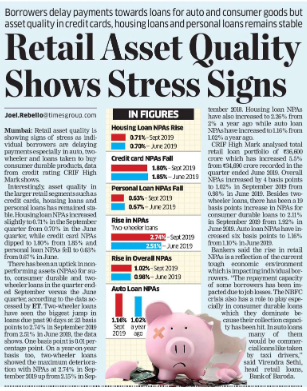Retail Asset Quality Shows Stress Signs - CRIF Insights
Retail asset quality is showing signs of stress as individual borrowers are delaying payments especially in an auto, two-wheeler, and loans taken to buy consumer durable products, data from credit rating CRIF High Mark shows.
Interestingly, asset quality in the larger retail segments such as credit cards, housing loans, and personal loans has remained stable. Housing loan NPAs increased slightly to 0.71 percent in the September quarter from 0.70 percent in the June quarter, while credit card NPAs dipped to 1.80 percent from 1.85 percent and personal loan NPAs fell to 0.63 percent from 0.67 percent in June.
There has been an uptick in nonperforming assets (NPAs) for auto, consumer durable and two-wheeler loans in the quarter ended September versus the June quarter, according to the data accessed by ET. Two-wheeler loans have seen the biggest jump in loans due the past 90 days at 23 basis points to 2.74 percent in September 2019 from 2.51 percent in June 2019, the data shows. One basis point is 0.01 percentage point. On a year-on-year basis too, two-wheeler loans showed the maximum deterioration with NPAs at 2.74 percent in September 2019 up from 2.15 percent in September 2018. Housing loan NPAs have also increased to 2.26 percent from 2 percent a year ago while auto loan NPAs have increased to 1.16 percent from 1.02 percent a year ago.
CRIF High Mark analyzed a total retail loan portfolio of Rs 36,600 crore which has increased 5.5 percent from Rs 34,690 crore recorded in the quarter ended June 2019. Overall NPAs increased by 4 basis points to 1.02 percent in September 2019 from 0.98 percent in June 2019. Besides two-wheeler loans, there have been a 19 basis points increase in NPAs for consumer durable loans to 2.11 percent in September 2019 from 1.92 percent in June 2019. Auto loan NPAs have increased six basis points to 1.16 percent from 1.10 percent in June 2019.
Bankers said the rise in retail NPAs is a reflection of the current tough economic environment which is impacting individual borrowers. “The repayment capacity of some borrowers has been impacted due to job losses. The NBFC crisis also has a role to play especially in consumer durable loans which they dominate because their collection capacity has been hit. In auto loans many of them would be commercial loans like taken by taxi drivers,” said Virendra Sethi, head retail loans, Bank of Baroda.
Source: Publication: The Economic Times, Delhi| Page No-12| 12th Dec 2019

